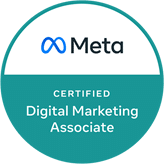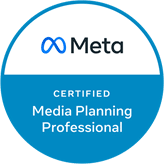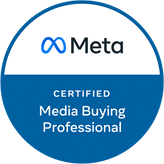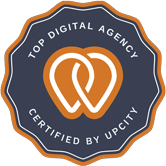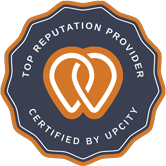





Thanks to a study that was earlier published by Sterlingsky, we learned that if a local listing manages to garner 10 reviews or more, they get a ranking boost in the Local Search Results by Google. The study also shed light on the fact that the recency and length of the reviews play an important role.
Last month, we saw the results of another study being published! This new study suggests that reviews with more than one upvote tend to stay in the top ten for around 100 more days as compared to those with one or no upvote.
Take a look at the chart below that clearly indicates the more upvotes a review gets, the longer it stays in the top ten.

Considering the fact that a previous study conducted in 2021 reported that the upvotes play no role in moving a review up in position, the findings of the latest study have surprised many.
Why This Is Important?
Having useful reviews appear in the top ten is bound to be more beneficial not only for your business but also for your customers. Hence, it is recommended that while asking your customers to leave a review, you also ask them to upvote the helpful reviews they find on your listing.
Are you interested in repairing your online reputation to increase your review quantity? Contact us to see how eBizUnvierse can improve your online reputation.

According to Google, links may become less important in the future. But a recent survey contradicts Google’s prediction. The survey says that links continue to be a critical ranking factor.
The survey anonymously asked 755 professional link builders about how they build links, what works best / worst for them, and what it really takes to make link building work for their business.
Here’s a summary of the most interesting findings and key statistics:
- 3% of link builders pay for links. We knew this number would be high, but didn’t expect it to be this high.
- We broke down the specific amount being paid and found that the average cost of a paid link is $83.
- However, when comparing those who pay for links VS those who don’t, we found that paying for links yields only an extra 2 links per month.
- In-house SEOs pay 75% more for links than niche site owners. Nobody seems to have a problem spending other people’s money.
- Looking at all links, when salaries are factored in, we found that experienced link builders can build links 41% cheaper.
- It takes an average of 3.1 months to see the impact of a link on the search ranking, with very few saying it takes longer than 6 months or less than 1 month.
- Guest posting is, by far, the most popular link-building tactic. It is somewhat contradictory to the point that the same people said creating content or linkable assets is the most effective link-building tactic.
- Google has told us that nofollow is a hint, not a rule. Our participants agreed, as 89.1% of link builders say nofollow links have an impact on rankings.
- Looking for a way to boost your results? Are you using social media for outreach? Link builders using social media build 22% more links than those who don’t.
This survey was published in November 2022, just before Google’s Link Spam Update. This update specifically targeted purchased links, showing that Google still considers links to be an important part of its ranking algorithm.
However, there is a possibility that Google is overestimating its ability to detect purchased links. Only time will tell if buying links is still a viable ranking strategy. So, for now, be careful and stay tuned for updates.
Are you having trouble keeping up with all the Google SEO updates recently? Contact us and see how we can help you maintain your high ranking without sacrificing your time.

There is a question that is being discussed all over the world now: Can ChatGPT answer all of our questions in the way we want? And if it can, will it revolutionize how we search for and ask for things on search engines? Well, you may wonder, discuss, or throw your opinions straightaway, but Microsoft is bringing ChatGPT’s AI question-and-answer service to its Bing Search, opening a whole new world of possibilities for us to interact with AI in everyday life.
This chatbot, launched by OpenAI, has become incredibly popular across the globe. Everyone, not just professionals, is using it for their projects, research, homework, writing essays, and getting answers to their queries. Some people loved it so much that they called it the “Google killer!” So, is it a code-red for Google, or are we going too far? Let’s find out.
Launched in November 2022, ChatGPT is based on OpenAI’s GPT-3.5 family of large language models and has been refined through supervised, reinforcement learning techniques. It can teach itself how to answer questions by using content drawn from the web that dates up to 2021. However, it has difficulty keeping up with recent and popular topics!
Keeping all that in mind, Microsoft is planning to launch a version of its Bing search engine that uses the artificial intelligence behind ChatGPT to answer search queries instead of simply providing a list of links. This feature will depict a human-like interaction, which Microsoft thinks will help it outflank Google.
So is it really a “Call the ambulance!” moment for Google? Well, experts in the industry are saying no. Google already has advanced AI and machine learning that can do the same as ChatGPT or even better. And to add to this, it has ways to detect AI-generated plagiarism and scraped content. In conclusion, it’s a “Call the ambulance, but not for me!” from Google’s side.
Are you getting the best return out of your digital marketing?
Need an extra pair of eyes to review your online game plan? Let our experts take a look at your current state and do a comprehensive
digital marketing analysis at no cost to you. Please call us at
(800) 379-2829 or
contact us today and we will get to work right away.






Last month it was reported that a new bug caused businesses to lose all of their reviews after their Google listings were auto-updated. Mike Blumenthal has issued a detailed report.
According to the Blumenthal report:
What is the New GBP bug?
A lot of businesses are saying they lost all of their reviews after their listings were auto-updated.
Here are some representative posts on the Google Business Profile Help:
- Change in Profile and lost reviews : Suddenly I woke up to see that the details about my
profile were changed and all the reviews were deleted. I am confused about how to approach this situation. Do guide me..
- All Reviews Gone : On Friday (11/4) I got an email from Google that my business profile was updated. Much of the information changed was changed to incorrect information or just removed entirely. I went to review and undo many of the changes. Today I noticed that all my reviews are now gone. I had 18+ reviews on my profile and I need to get them restored but I don’t know how to go about getting them restored.
- My genuine reviews have all been removed, 95 of them : 95 reviews have all been removed, even 5-6 1-star reviews. They also slightly changed my business; I was able to instate [sic] though. But I haven’t had no luck getting my reviews. Please help.
- Customer reviews disappeared : [105] reviews were lost all at once. Google had automatically updated my business information. They had shortened the business name to (Sydney Steemer) without the carpet cleaner. And changed my website information to a different link that also went to my website. This when I realized all the reviews had VANISHED!
- All reviews are gone : We had 170+ all 5-star reviews. One day they were all gone. In the settings it showed that google changed the name and phone number and short name for our business. After trying to contact them with the issue for over a week we still are not able to get reviews back or any answer. Also, some changes that google made we are not able to accept or decline.
The report further says after running through the typical scenarios where one might expect to lose reviews, it is clear that, in every instance, reviews disappeared immediately after the Suggested Edits update.
Mike discovered that in each case, Google had changed the Customer ID Number (CID), the identifier Google uses to tie all relevant information to a business, including reviews. But this is unusual because CID only changes when two listings merge or Google has hard-suspended a listing for guidelines violations and then reinstated it.
Mike’s report goes on to say, “Changing the CID and losing reviews with ——-a Suggested Edit update is a new and disturbing bug. It could happen to almost anyone for no reason or no apparent reason. Yet, in Google’s infinite wisdom, it could also be working as intended.”
We would suggest reading Mike’s report to learn what you need to do to recover from such an
event if/when it happens to you.
Is this not a real concern for your business because you currently don’t have a lot of reviews?
eBizUniverse can help your business increase the amount of authentic reviews across several different platforms like Google, Yelp, BBB, etc. Contact us today to see how we can help you manage your online reputation.

It is a well-observed fact that reviews affect your business’s rankings in local searches. But nobody has told you how or in what manner. And you may believe that the more reviews your business has, the higher its ranking gets. But is it actually the case? Well, Google has cooked up some algorithms for it, and we have uncovered everything for you!
In a recent study by SterlingSky on local ranking, we found that once a business or practitioner garners 10 reviews on listings, Google’s algorithms boost its ranking in local search results.
But that’s not all there is to it. After some time, the boost does not continue as you get or pump in more reviews. Reminds us of the law of diminishing returns, and in this case, it is there.
To help you with an example, here’s an image for you.

As you can see in the image above, when the reviews went from 3 to 16, there was a ranking
increase. But when the reviews increased to 31, not much happened there.
Many business founders stated that 10 could be a “ magic number,” as they observed a
sudden increase in ranking but not much later.
Rankings Are More Than Just Reviews:
Reviews are just one piece of the puzzle. Getting a ton of them does not mean you are going to
rank well. What’s important is that you have to have at least 10 reviews for a better listing. And
having them also helps in building trust and getting conversions.
Recency Matters:
While numbers tell their own story, the recency of reviews also matter. We found that when
businesses got reviews from time to time, their rankings surged. But as the stagnancy settled,
there was a decline. Therefore, by setting up a system that regularly updates your ratings, you
can enjoy being on top for a longer time.
Length Can Make All The Difference
The above-mentioned scenarios, lead us to the third one – Length matters! The more genuine, longer, and wordier reviews your business gets, the better it will perform in search rankings. So encourage your customers to express their opinions freely. Haven’t you noticed that one-star reviews are longer because the customer is genuinely writing about something that he didn’t like? Persuade you customers to do the same for positive reviews.
Key Takeaway
The bottom line here is that reviews can make or break your rankings. No matter how many or how long they are, reviews matter for your business – to become a trusted brand, a company that people genuinely talk about and a reflection of how well it is doing. Businesses that listen to their customers will always stay among them. And you can do so by asking your customers to express themselves!
Are your review numbers suffering because you’re too anxious to out-right ask for reviews?
eBizUniverse has a strategic business plan that utilizes your current contact/client list for new reviews. Contact us today to learn more about our email campaign options for your business.

It’s good news all around for those who’ve always wished to be able to crop the photos uploaded to their Google Business Profile posts!
Last month, a user spotted a cropping tool overlaid on the pictures she uploaded

to her Google Business Profile and took to Twitter to inform the world about this
latest development. It seems like the tool has been added to enable businesses to
make their GBP posts and updates as effective and presentable as they wish.
Why This is Important
Images play a major role in promoting products and services to prospective customers and/or clients. Any tool that can help enhance these images to make them more appealing is always welcome!
Are you getting the best return out of your digital marketing?
Need an extra pair of eyes to review your online game plan? Let our experts take a look at your current state and do a comprehensive
digital marketing analysis at no cost to you. Please call us at
(800) 379-2829 or
contact us today and we will get to work right away.






In August, Google announced a new big search ranking algorithm update, named the helpful content update – probably its biggest update in a decade.
What We Know
The helpful content update will target websites with a relatively high amount of unsatisfying or unhelpful content, where the content has been written explicitly for search engines to leverage rankings.
Unlike many Google algorithms that get applied page-by-page, this new helpful content update will be sitewide. That means that if Google determines your site is producing a relatively high amount of unhelpful content, it will impact your whole site.
This reminds us of the early Panda and Penguin update days. Just as a quick reminder – or in case you weren’t working in SEO a decade ago – those updates did a lot of damage back then, and we made significant changes to our SEO strategies to recover and protect our client websites.
Which Sites Were Likely Impacted?
According to Google, this update impacted these types of content the most:
- Online educational materials.
- Arts and entertainment.
- Tech-related.
This is because content written in those areas has historically been written more for search engines than humans.
These are the folks that were hit the hardest:
- Publishers focused on a broad range of topics like CNET, Forbes, etc.
- Sites that collect and monetize organic search traffic without providing unique value.
- Sites that have content created with AI tools like Jasper or Copymatic.
- Sites with SEO doorway pages created for the sole purpose of boosting rankings.
- Sites with spammy content with a very high keyword density.
Our Observations:
We were quick to run a deep ranking audit of more than 3.5K websites, and we are happy to inform you that so far, this update did not have any significant negative impact on our client’s websites. In fact, we have seen good improvement in positions for the sites we are working on. This implies that our content strategy, in conjunction with our other SEO efforts like on-page optimization and link building, is working well and protecting our client’s websites.

Are your GBP posts getting rejected? Well, that’s because GBP has added more restrictions to its list of guidelines. As stated in their support document under the “Avoid Spam” header, Google warns business owners to avoid uploading duplicate photos, posts, videos, or logos.
Here’s a screenshot of the other guidelines that you should know.

So, using original images & relevant content is the only way to get your posts accepted.
Need help? Get in touch with our technical support team for assistance.

Recently, it has been discovered that Google Maps is emailing customers who have posted a review for any business when their review is flagged as fake and, therefore, not posted.
It came to light after Lucio Laria – Consultant SEO International raised this issue on the Google Business Profile community. When a help forum titled Legitimate review started getting flagged as “Fake Engagement”, he wrote:
Hello,
I just settled my Google profile and asked my client for a review. Google is filing this review as a fake engagement when this person is a legitimate client of mine.
I’m waiting for this to be fixed before asking other of my clients for their reviews.
Why is this happening, and how can I fix it?
Thanks,
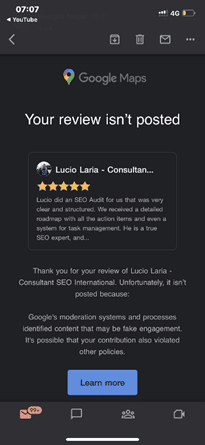
Among the many conjectured reasons and suggestions put forth by knowledgeable forum members are the following:
- It may be related to the review content. See Prohibited and restricted content. Ask the reviewer to delete it and then write a new review.
- It may be due to a problem with the reviewer’s account.
- Because the provider is in France and the client is in Argentina, the distance between them could be the reason.
- Ask the reviewer to try again, leaving a 4-5 sentence review, and add specifics about the services provided and, if pertinent, the location at which they were provided. If that fails, ask them to leave a review from another account.
The reviewer received the email notification about 15 minutes after posting the review. As the forum community pointed out, the review was being “filtered by an algorithm that enforces Google’s content policies”.
Why You Should Pay Attention to This Issue:
As we all know, getting legitimate reviews is not an easy task. It takes a lot of effort to impress a client and even more to convince the client to post a good review. It is disappointing when our sometimes hard-to-get legitimate reviews get taken down for “algorithmic” reasons, as requesting the client to post it again can be a bit awkward.
So, it’s crucial to learn how to get our good reviews to stick the better we can prep our customers and clients to get it right the first time.
Are you getting the best return out of your digital marketing?
Need an extra pair of eyes to review your online game plan? Let our experts take a look at your current state and do a comprehensive
digital marketing analysis at no cost to you. Please call us at
(800) 379-2829 or
contact us today and we will get to work right away.






Google updates its algorithm frequently. At times, they announce the major updates beforehand, and at times they inform after initiating one. The last update was rolled out on May 25th, and to learn about such updates, we had to wait for tweets & official answers from the team.
Google thought of improving this process and has created a dedicated Google Search ranking updates page. With the help of this page, you can check all the latest and previous updates easily.

If you wish to learn how Google improves the search engine, there are several articles from Google to help you. Also, its blog page has more information related to the updates. This page is definitely important for all site owners and SEO experts.
Need more details? Reach out to our support team for assistance.

To help businesses grow their eCommerce site, Google developer advocate Alan Kent recently hosted a video that outlines “8 tips” for SEO-optimizing an eCommerce site.
Here are the 8 tips that Alan believes will help you:
Tip 1: Make sure you have the technical basics in place – You need to ensure your URLs and internal links are friendly to crawlers.
Check out Designing a URL structure for E-Commerce Websites on Google Search Central for advice on how to design URLs for your website.
Tip 2: Create content relevant to users at different stages in their shopping journey – To check the breadth and quality of your site, think about likely searches by shoppers at different stages in their shopping journey. Once you have a set of queries, try them out. Does your site come up well-positioned? What about your competitors?
Tip 3: Be sure to mark up your product variant pages correctly – Product variants are when you have multiple colors or sizes of the same product. Informing Google of the relationship between the product pages can help Google better understand your site content.
The URL Inspection tool can also be used to check the status of individual pages.
Tip 4: For sales events that occur regularly, use the same URL across all event occurrences – This can help Google understand and trust the purpose of such pages. To identify problems, check the URL for promotional event pages on your site.
Tip 5: The “performance” of your web pages matters – Performance is important to users as a page that takes too long to load may be abandoned by them. It is also an important Google ranking signal. It can be particularly important if you use the same supplier-provided product description as other sellers online. The PageSpeed Insights report is useful for checking the performance of the web page.
Tip 6: Wait for it – Be patient to see the results. SEO, unfortunately, is a long game. Some ranking signals may take months to change. Worse, there is no guarantee of success. While it may take months to reap the benefits of a content creation strategy, it does not mean there is nothing you can do until then.
Tip 7: Seek professional help for your website – If you have done your best to improve your site but are still not getting the results you want, we’re here to provide expert SEO advice.
Tip 8: It’s all about the user – The ultimate goal for Google Search is to put the best possible content in front of the users. Algorithms change over time, but the ultimate goal does not. It does not mean you should not measure your site’s performance. It is still recommended to use tools such as Google Search Console and Google Analytics to collect data on your site.
Here is just one of our success stories that shows the importance of SEO! Ready to be our next success story?

As known to most SEO experts out there, Google renamed Google My Business to Google Business Profile last year while also rolling out more support for managing a business profile.
Going a step further, the search engine giant has now launched another feature that is bound to give small businesses operating out of homes a reason to be happy.
Google Business Profile now features a toggle that will allow businesses to hide their business address from customers if they wish to do so.

The screenshot above shows the businesses can now toggle ‘Show business address to customers’ on and off.
Why Is This Important?
This recently launched support feature is perfect for entrepreneurs operating virtual businesses that aren’t tied to a physical location. It can also prove to be quite helpful for all those home-based service operators who wish to avoid customers visiting.
Are you getting the best return out of your digital marketing?
Need an extra pair of eyes to review your online game plan? Let our experts take a look at your current state and do a comprehensive
digital marketing analysis at no cost to you. Please call us at
(800) 379-2829 or
contact us today and we will get to work right away.
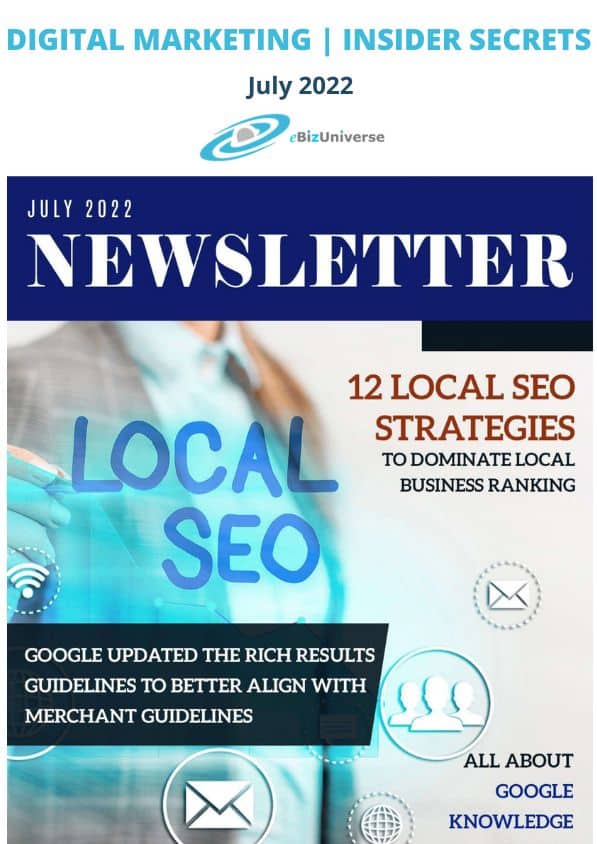





Local SEO strategy refers to the overarching strategy or process used to optimize your site content and online presence for higher rankings. Local SEO strategy focuses on improving business rankings in local search engine results pages (SERPs).
The difference between traditional SEO and local SEO is local SEO focuses your efforts on attracting customers near your physical location — and getting them through your door, while traditional SEO boosts your visibility on a wider scale.
The main benefit of local SEO is that it lets you take advantage of increased visibility in your immediate area.
How does it work?
Google uses numerous factors when ranking local content, but it predominantly focuses on these three signals:
- Relevance: Does your business listing match the searcher’s intent?
- Distance: How close is your business to the searcher at the time of the search?
- Prominence: Is your business well-known both online and offline?
When a user conducts a search using a location or “near me” and your business listing best matches the query, you’ll appear in Google’s local SEO 3-pack — a listing of the top three local businesses that meet the search criteria.
12 local SEO strategy tips to boost rankings and revenue:
- Optimize your local listings and citations
- Understand your local personas
- Conduct local keyword research
- Earn backlinks from local sources
- Write in-depth, local content
- Optimize your title tags and meta descriptions with local keywords
- Include an internal linking structure for location pages
- Update your website
- Improve your UX
- Post local content on social media
- Earn reviews from happy customers
- Track the results of your local SEO strategy

In true Google fashion, the search engine giant has now come up with an update for its rich results guidelines. These updated guidelines are meant to better align the rich results content with the overall Google merchant guidelines.
The new guidelines deny rich results for products that are widely prohibited and are known to facilitate harm in any way to anyone. For example, products that fall into categories like weapons, fireworks, recreational drugs, tobacco, gambling, etc.
The guidelines now have an additional section
Google rich results content guidelines, which have already come into effect, have been updated to add the following section:
“Don’t mark up content that promotes widely prohibited or regulated goods, services, or information that may facilitate serious and/or immediate or long-term harm to self or others. This includes content related to firearms & weapons, recreational drugs, tobacco & vaping products and gambling-related products.”
The new policy applies to all forms of markup
According to Google, the new guideline policies will apply to rich result markups in all forms, be it star ratings, prices, information regarding a product’s availability or other such factors. This, in turn, will impact the prohibited products’ structured data markup.
How does this affect your business?
If you are into the business of selling products that fall into any of the above-mentioned prohibited categories, this update definitely applies to you. All you can do right now is remove the structured data markup from your product pages because Google will not show rich results for them.
Although the search engine will not issue any manual action, the removal of rich results in itself will act as a penalty against violating the rich results content guidelines.

For years, Google’s SERPs have been including knowledge panels so users can find the required results quickly. In this article, we’ll discuss how knowledge panels are created and how they work.
Introduction To Knowledge Panels
Knowledge panels/entity boxes are information boxes that appear on Google’s search results page when you search for specific content. The main aim of these boxes is to provide users with the information they need in brief. The content you search for (for example – people, places, organizations, things) should be present in knowledge graphs to appear in knowledge panels.
Only limited categories or entity types (books and book series, educational institutions, government, local shops, companies, events, movies & film series, music groups & albums, and more) are considered for the knowledge graph. Also, only the most relevant or popular entities of every category are included in the knowledge graph.
Knowledge panels are different from business boxes, as the latter is based on Google Business. The best way to spot a classic knowledge panel is by looking for a share button in the upper area of the panel. Also, the entity type is specified below the name & depending on the category, various attributes are assigned & the available content is filled.
The image below is an example of a classic knowledge panel. Google prefers using different templates for various entities.

How Are Entities Selected For A Knowledge Panel?
Google has not given any criteria or procedure to select an entity for a specific category. But we have listed some of the most possible ways that Google uses to create a knowledge panel. Several websites that provide semi-structured data, for example – Wikipedia and Soundcloud, can be used by Google to select relevant entities for each category.
How Are Knowledge Panels Created?
In the Google patent, you can learn more about the basic methodology related to knowledge panels. The steps given below describe the basic process followed to create a knowledge panel:
- Finding relevant entities in the query
- Shortlisting relevant sources
- Creating the most appropriate search results
- Cross-checking whether the search query refers to the actual entity
- Determining an entity type/category for the entity requested
- Finalizing a suitable template for the panel (which should match the entity type)
- Arranging relevant content elements for the main entity from a trusted source
- Referring to another trusted source for content elements
- Attaching placeholders in the selected panel template with the finalized content elements
- Merging search results and knowledge panel on one SERP
How Are Images Selected For A Knowledge Panel?
The Google patent describes how images are selected for various entity types and incorporated into the knowledge panel. The steps given below are a shorter version of the same.
- Most relevant images are selected
- Cluster by similarity
- Most popular clusters are identified and separated
- Image format (portrait or not) is determined
- A portrait score is assigned
- The most representative image is selected
- The image is attached to the knowledge panel
The clustering of images into various categories depends on the proximity to the entity as well as the aspect ratio. We can also determine the possible categories by looking at Image Search.

In Google’s patent related to images, the images are labelled with attributes and are assigned to specific entities. These attributes are primarily determined by considering the initial image. Additional attributes can also be added by referring to similar images. It is believed that Google selects relevant images by using data from popular sites (Wikidata, Wikipedia, Wikimedia, social media profiles, magazines, and more).
Reasons Why Knowledge Graph Is Gaining Importance
The SERP features are gaining more importance every year, so it’s expected that the Knowledge Graph will also follow the trend. Since the entities are at the center of the Knowledge Graph, it will definitely affect the rankings and overall search results. To conclude, SEOs should not miss out on the Knowledge Graph when preparing their SEO strategies.
Are you getting the best return out of your digital marketing?
Need an extra pair of eyes to review your online game plan? Let our experts take a look at your current state and do a comprehensive
digital marketing analysis at no cost to you. Please call us at
(800) 379-2829 or
contact us today and we will get to work right away.
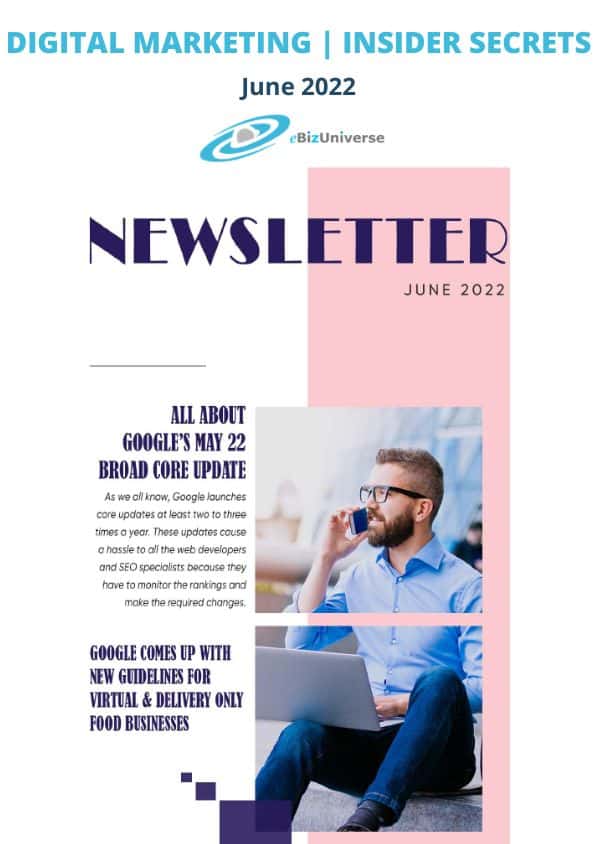





As we all know, Google launches core updates at least two to three times a year. These updates cause a hassle to all the web developers and SEO specialists because they have to monitor the rankings and make the required changes.
On May 25th, Google announced an update via a tweet.

This core update was further explained on Google Search Central. According to this article, Google makes changes to the ranking process to increase the accuracy of the search results. These improvements are called core updates. The core updates are not specific to certain sites but will certainly generate notable effects. Some sites’ ranking may drop, while others may rank better.
Also, Google said that if any site does experience a drop in its ranking, they don’t have to fix anything. These updates are meant to improve the system, helping under-ranked sites to get better traffic.
So, if your ranking suddenly drops, there’s nothing to worry about. You have not violated any webmaster guidelines. You just have to sit back and wait for the next core update. One last thing you can do is observe the sites that have ranked higher and try to figure out the factors that helped them.
Still have any issues? You can get in touch with our experienced team for assistance.

Last month Google laid out new, more specific guidelines to help the virtual food brands and delivery-only businesses with their Business Profiles on Google. These guidelines are meant for food businesses that don’t really have a physical location in an area, but they do re-package and deliver the local restaurants’ food.
The guidelines can be found in Google’s Guidelines for representing your business on Google, under the section Guidelines for chains, departments & individual practitioners.
Here’s a look at what these new guidelines have to say:

Final Takeaway
If you own a virtual food business, it is in your best interest to take a look at the new guidelines so that you can create a business profile on Google that isn’t suspended.

Recently Google’s Dikla Cohen gave a presentation on video indexing, which explains that video indexing does not rely on where and how you host your videos. You can host them yourself or choose from the most popular video hosting platforms and services.
With this, he announced Google is soon launching a new set of reports and tools in Search Console to make video indexing easier to track and diagnose.
With this new launch, the Video Page Indexing report will show a summary of all the pages that Google’s systems find with a video while crawling and indexing your website. At a glance, you can see how many video landing pages were indexed.
Issues will be grouped with a trend line and counts of the affected videos. For example, which videos are missing a thumbnail URL, with reasons – the largest impact ranked on top.
You can click on one of the rows to get more details, such as affected video page URLs. You can also download the list of examples and double-check them. So, you can narrow down the details and understand what is happening and how to resolve issues.
Once your website is updated; and you think you have resolved the issue you were facing, you can go back to the Video Indexing Report, go to that specific issue type, and then use the validate fix button to inform Google.
This way, you can initiate the recrawling of known URLs affected by the issue. And as the pages are being reprocessed, you will be notified if everything is resolved or if there are remaining issues.
But you will have to note that it can take some time to go through all the URLs.
If you wish to check the video indexing status, you can get there by entering the URL of the video landing page at the top of the search console. It will first show you the current status of that URL, as well as the video index status of the page. It will inform you whether Google detects a video on the page. And, if so, did they manage to index it. If a detected video is not indexed, it will list the reasons preventing it from being indexed.
Also, please note that Google indexes only one video per page, even when a page has multiple videos.
To summarize, with the new tools,
- You will be able to see how many video landing pages Google has discovered and how many of them were indexed.
- Examine reasons for unindexed videos on video landing pages.
- You can use the list of affected video page URLs to debug and fix issues.
- You can use the Validate Fix button to initiate recrawling of the known URLs affected by the issue.
- You will be able to check the video indexing status of a specific video using the URL inspection tool.
Are you getting the best return out of your digital marketing?
Need an extra pair of eyes to review your online game plan? Let our experts take a look at your current state and do a comprehensive
digital marketing analysis at no cost to you. Please call us at
(800) 379-2829 or
contact us today and we will get to work right away.
What is the first thing people do when searching for a particular product? The answer to this question is quite obvious and probably won’t surprise you – look for reviews. And statistics prove it. According to BrightLocal, in 2021, 77% of consumers reported that they always search the web for reviews before making a purchase.
Regardless of what product or service they may need, people constantly look for other customers’ experiences with the sellers before finally clicking on the “Purchase” button.
Even before the digital era became such an irreplaceable part of our existence, reputation has always significantly weighted the scales regarding purchases. There might not have been social media, but word-of-mouth marketing has always been here to tell us which products are worthy of our attention.
All that adds to the notion that maintaining a positive brand image should be a priority for every business that wants to grow on the market and attract new customers while retaining its existing ones.
If your small or big business has been struggling lately with reduced ROI because you’ve recently got a bad review or two, you may be in serious need of good reputation management services.
To help you make your comeback to the land of positive brand image, we’ve thoroughly discussed the elements of reputation management and how to use them to your advantage.
Keep on reading to see where you might have gone wrong and how to fix your mistakes.
What is reputation management, and why do you need it?
Reputation management is a term that we’ve mentioned a few times already, but we still haven’t explained what we mean by it. It’s time to change that.
The term itself is remarkably self-explanatory – the purpose of reputation management is to preserve the positive image of a personal brand and big or small business brands. The process requires a series of actions that tend to manage the information the public can find for a particular company.
With the presence of digital marketing and the increased importance of maintaining positive digital popularity, most of these actions take place online.
Of course, sometimes, marketing experts may also need to do their magic tricks to influence the brand’s reputation in the offline world. However, that is not of interest to us today.
Considering 49% of the people trust consumer reviews online as much as personal recommendations from people they know, the digital world is in more serious need of our attention.
Again, how people perceive your business can positively contribute to your growth or negatively impact it. Let’s see how.
The detrimental effects of a negative reputation
We hate to be the bearers of bad news, but the lack of a positive reputation will most likely seriously damage your business, no matter how big or small it is.
Regardless of how good your social media marketing strategy is or how visually appealing your posts are, the moment people sense something is off with the reputation of a particular business, they hit the “unfollow” or “unsubscribe” button.
And while you think this might be the least of your concerns if you are suffering from a bad reputation, this is only the beginning.
Even if some customers haven’t seen the bad reviews yet, with so many websites showing social media statistics and insights for brands around the corner, it will be tricky to cover your tracks and make up for the loss of followers.
If you don’t take control of the situation and do some crisis PR, things can escalate further. The worst-case scenario is to experience a significant drop in sales, making it very likely for your ROI index to hit the bottom.
The benefits of a positive brand image
On the bright side, a good reputation can bring plenty of benefits to a business. Because of their positive image, it is easier for the brands to build trust and a deeper connection with their customers. That is how a brand turns into a renowned and reliable business with increased ROI.
Usually, apart from offering quality products or services that people can enjoy, those brands do their best to ensure a positive experience for their customers. Thanks to that very same experience, people are more likely to become loyal, which is something businesses always should strive for.
While that’s a subject to an entirely different topic, loyalty is a crucial factor that ensures your customers will stay with you and continue their “relationship” with your product even if you get negative reviews that start affecting your reputation along the way.
Everything mentioned thus far is just the tip of the iceberg. Don’t even get us started on how a good reputation can significantly increase your sales and revenue.
How does reputation management work in digital marketing?
Businesses revolve around digital marketing. So it is only natural to wonder how to make your reputation management strategies work in the digital marketing world.
One of the main perks of digital marketing is the variety of channels you can use to reach your target audience and your customers. Today it is easier than ever to access your clients’ thoughts, opinions, and experiences, and not using those to your advantage would be a total waste.
Hence it is essential to be fully aware of the categories different channels fall into. Let’s take a look.
Owned Media.
Every channel that you have control over is part of your owned media. Owned media is an umbrella term for your websites, personal blogs, social media channels, and other third-party sites.
Bringing your A-level game for your SEO strategy is crucial to ensure your customers get a good perception of your services.
Paid Media.
Featuring a business on external websites often requires a good investment of money and marketing efforts. Those websites or networks are also known as paid media.
There’s a whole field in digital marketing that strives to take businesses out there for all to see. Thanks to PPC advertising, brands get external traffic and manage to attract new customers.
Earned Media.
Every time someone shares, reposts, mentions, or reviews your content, services, and products on their owned media, you get external web entities you didn’t pay for.
That is probably the most valuable media of all as it helps businesses organically grow their revenues.
3 mistakes to avoid and what to do instead
Reputation management is an art of its own. It requires the possession of plenty of skills that marketers can later implement in the processes. Practice makes perfect, but it always leads to making a mistake or two on the way. To help you learn how to execute a successful reputation strategy, we’ve listed the actions (or lack of them whatsoever) that may rather spoil it than elevate it.
Turning a blind eye to customers’ reviews
Whether good or bad, not responding to the reviews your customers leave on your owned media is a mistake #1 a business can make. After all, the replies of 89% of the participants in BrightLocal’s study showed that they are more likely to buy from brands that respond to all online reviews.
Leave the other benefits aside. Responding to your reviews shows that you take accountability for your (lack of) actions, products, or management skills.
Every business should strive for positive reviews. However, bad reviews are not the end of the world, as long as they are not an everyday occurrence. What’s more important is whether you are using the right strategies for handling negative customer reviews.
Solution:
The most valuable lesson you can learn is to address all of your negative reviews, even if you think they are unfair. Find your way to get into your customers’ shoes and see where you might have done them wrong.
Showing your love and appreciation for the positive reviews you get is equally essential to dealing properly with your negative feedback.
Depending on the popularity of your business, you may be getting new reviews weekly or even daily. Hence it might be a good idea to pick a day or two in the week to conduct your reputation management audit where you find and respond to all new reviews.
Once you know the general attitudes toward your business, it is time to take matters into your own hands and do your best to keep or change the public opinion.
Overlooking the importance of social media
If you think you are too cool for social media platforms, we hate to burst your bubble, but you are not. In fact, no one is. Social media presence is an integral factor for any successful business in our digital era.
The lack of social media makes you look shady in the eyes of your potential customers. They have no place to find more relevant information about your products and services, but what’s more important, they have no way of contacting you whenever questions arise.
Solution:
If you already haven’t, the first thing you should do is dive deep into the world of social media channels. Pick all relevant platforms for your business and use them to skyrocket your personal brands.
The next step is to analyze and create an exceptional brand strategy to help you grow faster. Start creating meaningful content that brings value. Dedicate yourself to showing your audience the perks of your products or services.
Earlier in our article, we spoke about the significance of loyalty. You can speed up the loyalty process by managing your social media right. Be there for your customers, reshare their stories, show them your gratitude, and you are bound to increase your positive reputation.
Deciding on a tone of voice (ToV) is crucial when developing a brand. That is how you will address your audience anytime you post updates about your products or reply to comments and negative reviews.
Once you’ve picked a relevant tone of voice for your audience, all you need to do is be consistent. Use it even when handling negative reviews – we guarantee your customers will appreciate it.
You probably know you can use SEO to leverage the reputation of your business. Doing keyword research to produce valuable content is a norm most companies, big or small, follow.
But did you know that you can also use it to remove negative results from the first page of Google?
Usually, marketing experts use SEO to optimize and rank different pages of the same website. However, when reputation management for negative reviews is on the line, the tactic is different.
Solution:
If you are dealing with some negative feedback visible on the first page of Google, the best way to remove it is to rank nine other websites ahead of it.
As you can probably guess, that is time-consuming, and results won’t follow immediately.
You will need to perform keyword research and look for the terms that produce negative results. Once you find them, focus on those words and do your SEO magic.
- Backlinks can help you rank other pages and websites on Google. Whether you do internal or external link building, do not overdo it.
- Create and set business profiles on third-party websites to help your rankings. Yelp, Trustpilot, or Google My Business are popular options you can try.
- Engage in digital PR, events, sponsorships, and influencer marketing to get positive brand mentions.
Differences between branding and reputation management
Are personal brand and reputation one and the same? Definitely not, although some often confuse the two. Those two are not mutually exclusive, but they require different techniques, tactics, and strategies.
Creating a brand is all about showing yourself to the world in the most authentic way. It is the story of who you are, what you want to achieve, and anything else you think might interest your audience.
Reputation is everything your customers think of your brand. They shape your past and depict your future. Reputation is earned and highly depends on your products/services and how you treat your customers.
But does a strong brand equal a positive reputation? While this is often the case, a powerful brand doesn’t need to have the best reputation. The reason is that your brand shows your relevance, while your reputation – your credibility.
Reputation management software
When demand is high enough, you may consider using reputation management software to help you do your work.
MyReviewEngine is a helpful tool that assists you in gathering reviews from your customers to improve the reputation of your business. It also helps you manage your reputation like a pro by aggregating your ratings and analyzing the activity for 90 days.
BirdEye allows you to follow up with reviews from over 150 online sources. One of the main perks of this SaaS software is the opportunity to have it manage your social media accounts and conduct relevant surveys for your audience.
To ensure inclusivity on all marketing channels, Cision lets business owners reach audiences across traditional and social platforms. Furthermore, the software helps with proactive PR outreach, giving you access to a list of influencers compatible with different niches and industries.
Reputation management is not a one-time thing. It is a constant battle to stay relevant, to stay on top. The biggest takeaway of this article is not to leave your reviews hanging.
While it is essential to address them, what is even more crucial is to learn your lessons. Your reviews can give you valuable insight into how customers feel about your products and services. Think of your negative feedback as a way to upgrade and become better at what you do.
Be present and take control of your reputation. Make it work for you. Not against you.
Author Bio:
Terry Tateossian, Founding Partner of Socialfix Media is a fourth-generation entrepreneur who is recognized as an Inc. 5000 America’s Fastest-Growing Private Companies, Forbes’ Top Women in Business, Fastest Growing Women Presidents by WPO, and 40 Under 40 Business Leaders by NJBIZ. Terry has been featured for outstanding leadership and career accomplishments in numerous industry publications as an engineer, a thought-leader in technology, and an innovator in the field of marketing. But her favorite and toughest earned title is being “Mom” to her 2 children.






In a new move, Google has announced the use of the AI approach to update the operation hours for over 20 million businesses around the globe in the next six months. Also, Google’s AI algorithms are busy figuring out if your posted business hours are accurate.
Google said, “We developed a machine learning model that automatically identifies if business hours are likely wrong, then instantly updates them with AI-generated predictions.”
How Does It Work?
The AI considers multiple factors, such as:
- The last time you updated your hours
- What they know about other shops’ hours
- The Popular Times information for your shop determined by location trends
Then, the algorithm analyzes the business hours of other similar shops that are nearby, information from the shop’s website, and Street View images of the shop’s storefront. Also, they will look specifically for business hour signs to determine the most accurate business hour prediction.
Google will take the help of the Google Maps community — including Local Guides and even the business owners themselves through their Google Business Profile — to verify the information they have predicted.
What Do You Need To Do?
All the business owners located in Argentina, Australia, Chile, France, Japan, Mexico, New Zealand, Peru, or the United States, should prepare their staff to expect inquiry calls powered by Google’s conversational AI asking about their business hours.
Also, check Google Maps from time to time to ensure that Google has correctly listed the timings, in case they have been changed without your input.

Google performing random display testings are no longer surprising. This time around, it is Google Maps testing the position of local listing previews.
Recently, one of the users noticed that when a specific listing is clicked on from the Google Maps search results that appear on the left-hand side, the local listing pops up in a new position.
Instead of its original position on the left bar, the local listing preview now hovers in a new position, overlayed on top of the map. So far, this new position testing seems to be limited to the Google Maps interface for the desktop.
Here’s a look at the local listing overlay box:

Normally, there would be no overlay box hovering over the map, and the local listing details would appear in the left bar, pushing the search results to the bottom footer.

We have highlighted the main steps involved in setting up an e-commerce site & depending on the work required in each step you can determine the price of the project.
Step One –
- Calculate the time required to set up a WordPress site, install plugins, install a WordPress theme, and meet a client’s requirements.
Step Two –
- Calculate the time you need to finalize images. Mostly, it depends on whether you are –
- Using existing images
- Making new images
- Modifying manufacturer’s images
Step Three –
- Determine the number of products or SKUs included in the project.
- Also, make a note of whether you will take the content from an old site, create your own new content, or reword the manufacturer’s website content.
- Lastly, you need to know if you must create custom category pages and the amount of product information that will be provided.
Step Four –
- Customizing a plugin may need about 20-30 mins, so extra features like Shipping Plugins, Invoicing Plugins, & more should be noted down.
After you have a good idea of the level of work required, you can give an estimated price range for the project. If the estimate is approved by the client, you can charge by the hour to ensure you are paid for your work.
Have any questions? Get in touch with our experts for assistance.
Are you getting the best return out of your digital marketing?
Need an extra pair of eyes to review your online game plan? Let our experts take a look at your current state and do a comprehensive
digital marketing analysis at no cost to you. Please call us at
(800) 379-2829 or
contact us today and we will get to work right away.






In a shocking move for SEO experts, Google Analytics 3 will stop collecting new data July 1, 2023 onwards.
Google posted a notice on Google Analytics stating, “Two and a half years ago, we introduced Google Analytics 4 to address these evolving measurement standards and help businesses succeed. Google Analytics 4 has the flexibility to measure many different kinds of data, delivering a strong analytics experience that’s designed for the future.
It allows businesses to see unified user journeys across their websites and apps, use Google’s machine learning technology to the surface and predict new insights, and most importantly, it’s built to keep up with a changing ecosystem.”
Explaining the difference between Google Analytics 3 and Google Analytics 4, Google says, “GA3 was built for a generation of online measurement that was anchored in the desktop web, independent sessions and more easily observable data from cookies. However, this measurement methodology “is quickly becoming obsolete.
While GA4 operates across platforms, does not rely exclusively on cookies and uses an event-based data model to deliver user-centric measurement.”
Further, Google says GA4 is advanced in terms of privacy as it provides more comprehensive and granular controls for data collection and usage — and it does not store IP addresses, a necessary adjustment required by data privacy regulations in many locations.
Google promises that GA4 will better support your business by helping you:
Understand your customers across touch points – Get a complete view of the customer lifecycle with an event-based measurement model that isn’t fragmented by platform or organized into independent sessions.
- Improve ROI with data-driven attribution – Use data-driven attribution to analyze the full impact of your marketing across the customer journey.
- Measure engagement and conversions – With business and compliance needs in mind. With GA4, you’ll have country-level privacy controls that enable you to manage and minimize the collection of user-level data — like cookies and metadata — while preserving key measurement functionality.
- Get greater value from your data – With predictive insights about user behavior and conversions generated by machine learning.
- Easily activate your insights – With expanded integrations with other Google products — like Google Ads — making it easier to optimize your campaigns.
What to do now:
From July 1, 2023, all standard Universal Analytics properties will stop processing new hits, and from October 1, 2023, 360 Universal Analytics properties will do the same. After that, you can access your previously processed data in Universal Analytics for at least six months.
If you want to build the necessary historical data before Universal Analytics stops processing new hits, you need to move to Google Analytics 4 as soon as possible.

The recently updated Google Business Profile Help document states that you may now have to verify your Google Business Profile through “more than one method”.
Here’s a look at exactly what the updated document says.
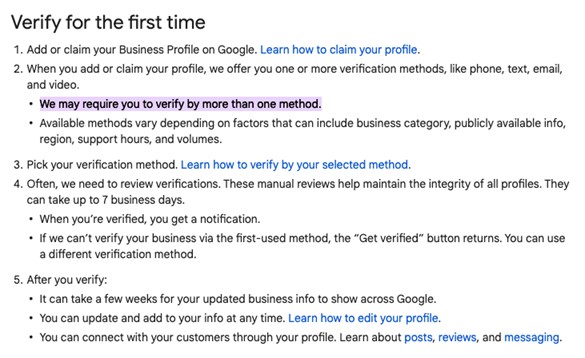
It looks like Google rolled out this update, apart from pushing for video verification, to hopefully tackle one of the persisting problems – fake locations on Google Maps.
Check out this video to better understand the steps to getting your business verified on Google.
Final Takeaway
There’s really no way you can build a strong online presence without getting your business verified on the search engine giant. Click here for more information on Google Business Profile verification and all the options available to you.

Google has now allowed all U.S. auto advertisers to advertise their vehicles on its page. Customers shopping for vehicles online will now be able to see vehicle details such as make, model, price, mileage, and advertiser name. The latest format of the advertisement is given below. When a customer clicks on the ad, it directs the customer to the vehicle description page.

Advantages Of Vehicle Ads:
- Vehicle ads are designed to help you reach your potential customers easily.
- Advertisers can now optimize their site accordingly to get a good conversion rate (both online and offline).
- Users will only see the most relevant listings from your inventory, helping you get qualified leads.
What You Need To Know:
- Both new & used vehicles can be advertised
- Only non-commercial vehicles can be advertised
- Only available for U.S. auto advertisers
How To Get Started
Are you getting the best return out of your digital marketing?
Need an extra pair of eyes to review your online game plan? Let our experts take a look at your current state and do a comprehensive
digital marketing analysis at no cost to you. Please call us at
(800) 379-2829 or
contact us today and we will get to work right away.
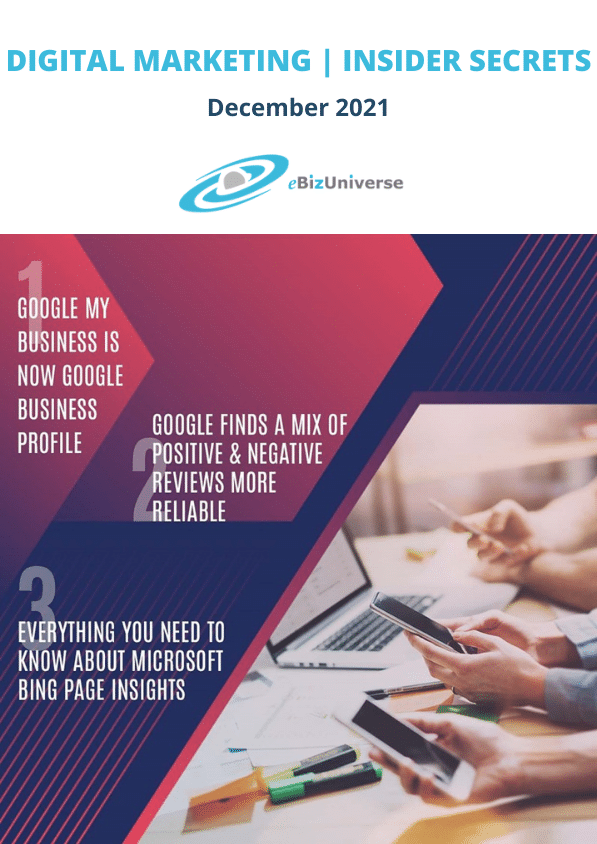





According to the latest announcement, Google has renamed “Google My Business” to “Google Business Profile”. The Google My Business app will mostly retire in the coming years.
Benefits of the latest update include:
- To get to your profile, you can search your business name on Google, go to Google Maps app, or search for ‘my business’ on Google Search.
- You can complete the verification, resolve any issues with your profile, and edit your details easily including address, store hours, photos, and more.
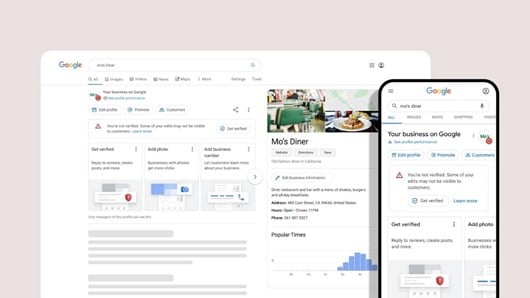
- In the coming months, merchants can complete their account setup directly on Google Search and Google Maps.
- You can see whether your profile is visible to the public. If not, the necessary steps will be included.
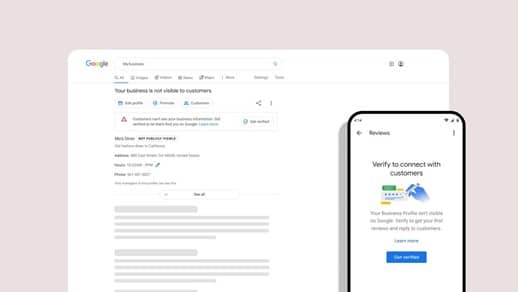
- Google Search and Google Maps now have additional tools to help you better manage your business profile.
- The changes in-line with this update will soon be evident on Google’s Help Center, Community & Support channels.
- The GMB website will be renamed to Business Profile Manager and will now support larger businesses having multiple profiles.
- Google expects smaller businesses to manage their profiles on Search & Maps.
- Google has shared some new ways to help you connect with your customers easily and increase your business.
After reading the above brief related to the latest update, we recommend you keep a track of the emails & videos from Google or follow Google Business Profile on Twitter so that you can get the best out of your business profile.
Analyze your site?
Customers prefer business accounts that have reviews on their profiles. Reviews next to your Business Profile in Maps and Search can drive traffic to your site & help you get more customers. Google has provided some tips to help you get more reviews.
Best practices listed by Google include:
- Verify your Google Business Profile
- Remind customers to leave reviews
- Reply to reviews to build customer trust
Many business owners have a mindset that only positive reviews can help improve their business, but it’s not true.
Google recently updated the guidelines page and added a new point, “Value All Reviews”. According to this point, honest & objective reviews are more helpful for new customers. A mix of positive & negative reviews is more reliable & trustworthy. The team at Google also suggests responding to customer reviews so that customers know that you care. In case the reviews don’t follow Google’s posting guidelines, the business owner can send a removal request.
Google thinks having 99% positive reviews is not natural, and the team may audit the reviews if such a case exists. So, it’s totally fine to have mixed reviews & this won’t even affect your rankings!
Finally, we think businesses can now share their review link to all customers without fail and stop worrying about negative reviews. However, make sure that you are responding to such reviews.
If you need help with review management, we are just an email away.
See How You Can Improve Your Review Management!

On 23rd November, Microsoft Bing announced the launch of a new feature, Page insights. Now users will see a lightbulb icon on the right-hand side of the search results that provides more details about the search result.
So, what does Page Insights do? Microsoft said, “it provides summarized insights from a page on your search results so you can find what you’re looking for faster.”
Here’s how it looks.

Adding more information, the company said, “Page Insights help you verify that the source is relevant to your needs, helps you get caught up to speed at a glance on top factoids you didn’t know about, and lets you jump straight to the relevant section of the page when you click ‘Read more’ for a specific question.”
If you wish for more details, there is a section to “explore more” that will help you find relevant search results.
But as of now, the feature is only available on desktop search results because of the screen size required to properly display the results.
Are you getting the best return out of your digital marketing?
Need an extra pair of eyes to review your online game plan? Let our experts take a look at your current state and do a comprehensive
digital marketing analysis at no cost to you. Please call us at
(800) 379-2829 or
contact us today and we will get to work right away.

































































